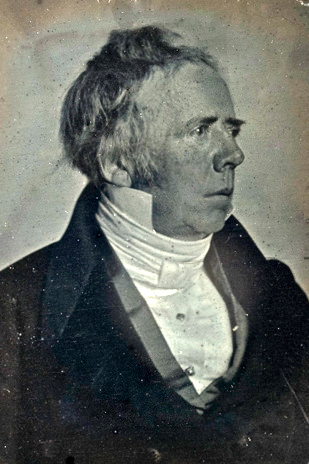<Back to Index>
- Physicist Hans Christian Ørsted, 1777
- Writer John Galsworthy, 1867
- King of Prussia Friedrich Wilhelm I, 1688
PAGE SPONSOR

Hans Christian Ørsted (often rendered Oersted in English; 14 August 1777 - 9 March 1851) was a Danish physicist and chemist who is most widely known for observing that electric currents induce magnetic fields, an important aspect of electromagnetism. He shaped post-Kantian philosophy and advances in science throughout the late 19th century.
In 1824, Ørsted founded Selskabet for Naturlærens Udbredelse (SNU),
a society to disseminate knowledge of the natural sciences. He was also
the founder of predecessor organizations which eventually became the Danish Meteorological Institute and the Danish Patent and Trademark Office. Ørsted was the first modern thinker to explicitly describe and name the thought experiment. A leader of the so-called Danish Golden Age, Ørsted was a close friend of Hans Christian Andersen and the brother of politician and jurist Anders Sandøe Ørsted, who eventually served as Danish prime minister (1853 – 54). The Oersted (Oe), the cgs unit of magnetic H-field strength, is named after him. Ørsted was born in Rudkøbing. As a young boy Ørsted developed his interest in science while working for his father, who owned a pharmacy. He and his brother Anders received most of their early education through self-study at home, going to Copenhagen in 1793 to take entrance exams for the University of Copenhagen, where both brothers excelled academically. By 1796 Ørsted had been awarded honors for his papers in both aesthetics and physics. He earned his doctorate in 1799 for a dissertation based on the works of Kant entitled "The Architectonicks of Natural Metaphysics". In 1801 Ørsted received a travel scholarship and public grant which enabled him to spend three years travelling across Europe. In Germany he met Johann Wilhelm Ritter, a physicist who believed there was a connection between electricity and magnetism.
This made sense to Ørsted since he believed in Kantian ideas
about the unity of nature and that deep relationships existed between
natural phenomena. Their conversations drew Ørsted into the study of physics. He became a professor at the University of Copenhagen in
1806 and continued his research with electric currents and acoustics.
Under his guidance the University developed a comprehensive physics and
chemistry program and established new laboratories. On 21 April 1820, during a lecture, Ørsted noticed a compass needle
deflected from magnetic north when an electric current from a battery
was switched on and off, confirming a direct relationship between
electricity and magnetism. His
initial interpretation was that magnetic effects radiate from all sides
of a wire carrying an electric current, as do light and heat. Three
months later he began more intensive investigations and soon thereafter
published his findings, showing that an electric current produces a
circular magnetic field as it flows through a wire. This discovery was
not due to mere chance, since Ørsted had been looking for a
relation between electricity and magnetism for several years. The
special symmetry of the phenomenon was possibly one of the difficulties
that retarded the discovery. It is sometimes claimed that Gian Domenico Romagnosi was
the first person who found a relationship between electricity and
magnetism, about two decades before Ørsted's 1820 discovery of
electromagnetism. However, Romagnosi's experiments did not deal with
electric currents, and only showed that an electrostatic charge from a
voltaic pile could deflect a magnetic needle. His researches were published in two Italian newspapers and were largely overlooked by the scientific community. Ørsted's
findings stirred much research into electrodynamics throughout the
scientific community, influencing French physicist André-Marie Ampère's
developments of a single mathematical formula to represent the magnetic
forces between current-carrying conductors. Ørsted's work also
represented a major step toward a unified concept of energy. In 1822, he was elected a foreign member of the Royal Swedish Academy of Sciences. In 1825, Ørsted made a significant contribution to chemistry by producing aluminium for the first time. While an aluminium-iron alloy had previously been developed by British scientist and inventor Humphry Davy, Ørsted was the first to isolate the element via a reduction of aluminium chloride. In 1829, Ørsted founded Den Polytekniske Læreanstalt ('College of Advanced Technology') which was later renamed the Technical University of Denmark (DTU). Ørsted died at Copenhagen in 1851, aged 73, and was buried in the Assistens Cemetery in the same city. The centimetre-gram-second system (CGS) unit of magnetic induction (oersted) is named for his contributions to the field of electromagnetism. The 100 danske kroner note issued from 1950 to 1970 carried an engraving of Ørsted. The buildings which are home to the Department of Chemistry and the Institute for Mathematical Sciences at the University of Copenhagen are named The H.C. Ørsted Institute, after him. The first Danish satellite, launched 1999, was named after Ørsted. Two medals are awarded in Ørsted's name: the Oersted Medal for notable contributions in the teaching of physics in America, awarded by American Association of Physics Teachers, along with the H.C. Ørsted Medal for Danish scientists, awarded by the Danish Selskabet for Naturlærens Udbredelse (Society for the Dissemination of Natural Science), which Ørsted founded.
Ørsted was a published writer and poet. His poetry series Luftskibet ("The Airship") was inspired by the balloon flights of fellow physicist and stage magician Étienne-Gaspard Robert. Shortly
before his death, he submitted a collection of articles for publication
under the title "The Soul of Nature". The book presents Ørsted's
life philosophy and views on a wide variety of issues.